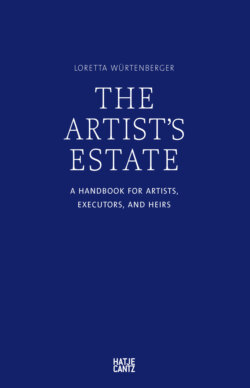Читать книгу The Artist's Estate - Группа авторов - Страница 12
1. An Artist’s Estate in the Legal Sense
ОглавлениеThe law provides the first answer to the question of what an artist’s estate is. Generally, the estate of an artist is assigned the general definition of an “estate,” where this is understood to include the assets and any debts left behind by the deceased. This means that the sum of all the assets and liabilities of a natural person do not die with the deceased, but will instead be transferred to his or her heirs. In relation to heirs, an estate is referred to as an inheritance.3 From a legal perspective, this includes everything the artist leaves on death: the car in the garage and the pans in the kitchen, just as much as the canvas in the studio. In the context of succession, the law does not differentiate between art and other assets of an estate nor between the estate of an artist and that of another person. For the law, the only relevant question is organizing the restructuring of financial assets—including corresponding rights and obligations—that becomes necessary due to the death of an individual.
With respect to the legal definition of the term “artist’s estate,” it is important to differentiate between the Anglo-Saxon and continental European jurisdictions. In the Western world, these two legal systems dominate the allocation of assets on death. Correspondingly, this also explains the partially different understanding of the term estate. A distinction needs to be made between the legally separate estate as it commonly exists in the Anglo-Saxon jurisdiction (e.g., the United Kingdom und the United States) and the system of universal succession, which prevails in continental Europe (e.g., Germany and France). Depending on the laws governing the succession of the deceased, the transfer of assets takes place in different ways and at different points in time.
In Anglo-American common law, the estate as such is central to the inheritance and not the heirs or the community of heirs. Accordingly, heirs are not per se liable for debts or tax liabilities, but rather the estate itself is taxable via its executors or administrators. Lawyers in Anglo-Saxon jurisdictions normally refer to beneficiaries of an estate rather than heirs when describing individuals who benefit from an estate. In the Anglo-Saxon tradition, the estate first has to be administered by a person appointed to do so (usually an executor), who may simultaneously also be a beneficiary.4 It is only at the end of this process that property is handed over to the beneficiaries, who may be natural persons or, in the case of artists’ estates, often, additionally, a charitable organization.5
During this interim period when the estate is being administered, the period of administration, the surviving relatives are very limited in their powers of disposal, even though interim distributions and bequests are possible.
In the case of “universal succession” in continental European legal domains (like Germany, France, Italy, and Spain), by contrast, the estate as a whole is already transferred to one or more heirs upon death. In this European tradition, several heirs as a community of heirs and / or a single heir take the place of the deceased. The succession includes assets as well as liabilities. An individual item can be allocated to one heir by means of a bequest, but not inherited in a legal sense. A joint heir only obtains sole ownership of individual items in the estate by means of a separate partition agreement. If the artistic body of work was organized in the form of a business, in some countries there is also the possibility of a tax-saving continuation of operations, which we will look at later.
In practice, the legal differences between estates in the two legal spheres can mean an immediate, shared right of disposal over the works bequeathed, coupled with the person- and the portion-of-the-estate-related (tax) liabilities, as it did for the heirs of Sigmar Polke for example. After the death of Willem de Kooning, the executors who had been appointed (attorney John Eastman and daughter Lisa de Kooning) first had to clarify tax-related questions on behalf of the estate with the American Internal Revenue Service (IRS) and have the estate as such pay taxes, before Lisa de Kooning and the Willem de Kooning Foundation were able to obtain ownership of the works intended for them. In the case of Donald Judd, it took four years for inheritance-related matters to be clarified and assets permitted to be transferred to the ownership of the Judd Foundation, which had been established according to his wishes.
According to the legal classification in the two legal realms, the term“estate” is also subject to a time limitation. Under Anglo-Saxon common law the period of administration ends when the net assets have been transferred to the beneficiaries. After the estate’s liabilities have been settled and administered, the beneficiaries assume the legal position of owner by virtue of the transfer, which supersedes the preferential treatment. From a legal perspective, the Rauschenberg or Judd Foundation, for example, are also not artists’ estates. One speaks here instead of an artist-endowed “foundation.” In the continental European system, the transfer takes place by means of universal succession upon the death of the decedent. Here, the term estate becomes legally obsolete at the latest with the expiry of the period for disclaiming an inheritance. Accordingly, in a strict sense, each individual who calls an artistic legacy his or her own is therefore no longer an administrator of an estate, but rather of his or her own legal circumstances as inherited from an estate. But what child of an artist really wants to say that he or she manages the “inherited material assets” of his or her mother or father—even though this would actually be accurate?
